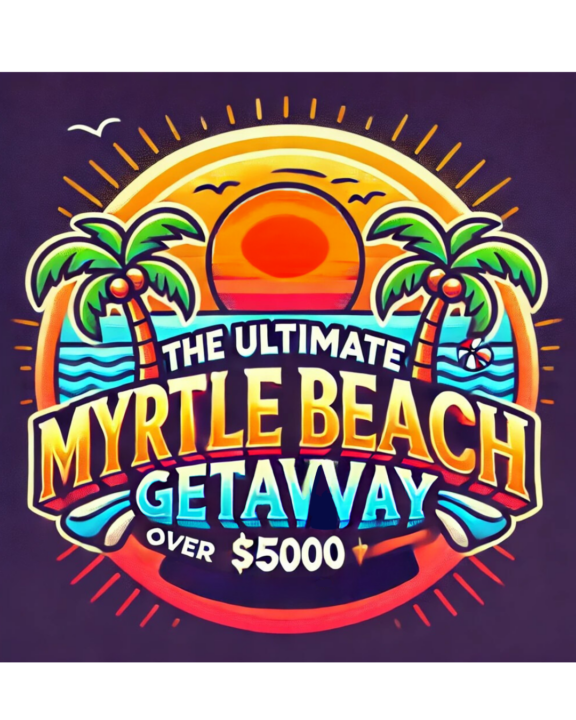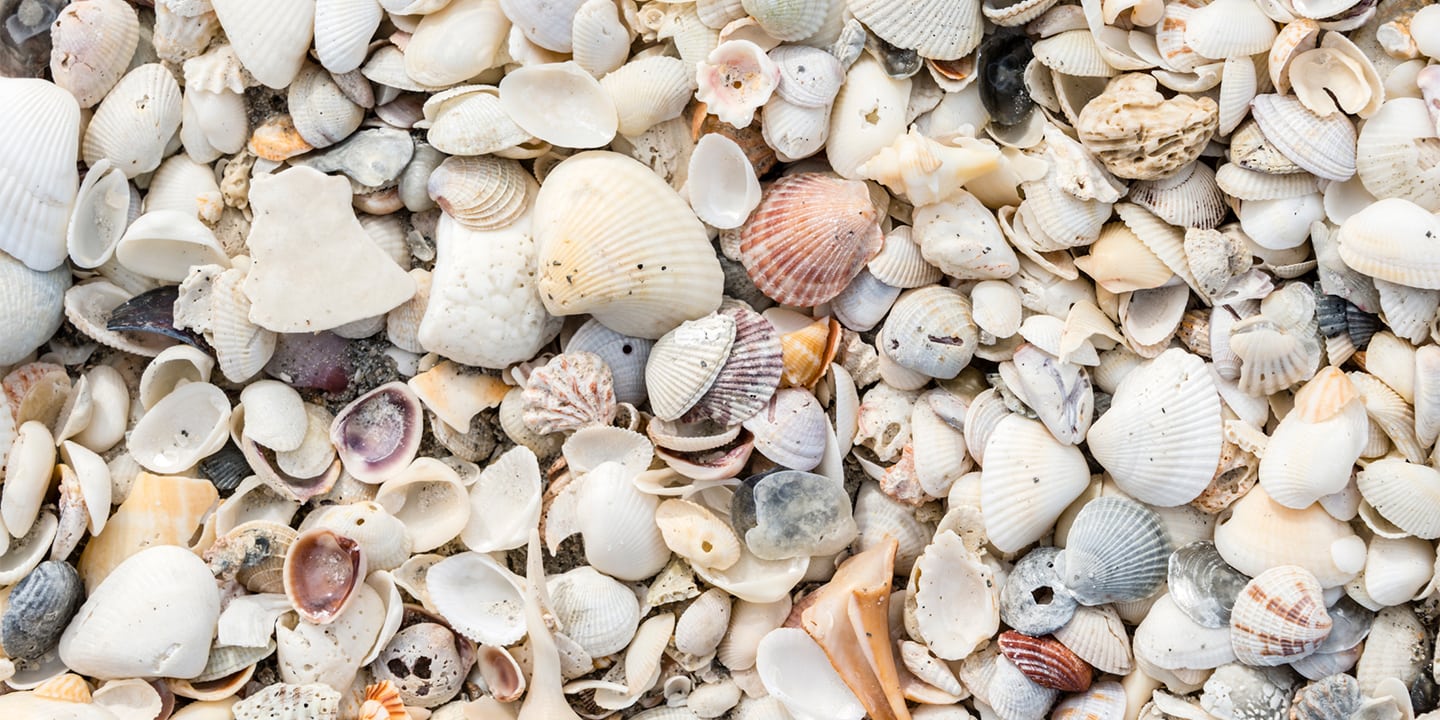
Tourism News
Myrtle Beach Seashell Guide
Myrtle Beach Seashell Guide: When To Look and What You Can Find!
Hunting for Myrtle Beach seashells is a favorite activity for many Grand Strand visitors. Part of the fun can be identifying your finds, particularly when you discover a pristine or unique shell along the shore. While there are dozens of varieties, we’ve chosen to highlight some of our favorites and the seashells you’re most likely to encounter locally.
Because the Grand Strand reaches more than 60 miles, knowing how to find the best shells and where to look can seem impossible, so we’ve gathered shelling tips and tricks to make your exploring worthwhile. Use this guide to identify your treasures, and remember to be respectful of wildlife as you hunt by leaving anything living where you’ve found it.
Happy shelling!
Beaches With Seashells Around Myrtle Beach
If you’re staying at an oceanfront hotel, the most convenient place to hunt for seashells will be right outside the door, but you may have better luck at less populated beaches. Nearby, Huntington Beach State Park and Myrtle Beach State Park are great options for shelling, and areas south of Myrtle Beach, such as Garden City Beach, Litchfield, and Pawleys Island, can yield an excellent variety of seashells. Anytime you’re on an excursion, cruise, or kayak tour that includes an island stop, keep your eyes peeled for banded tulips, heart cockles, and other seashell varieties.
Where To Find Myrtle Beach Seashells
If you’re shelling only along the Myrtle Beach shoreline, you might be missing out. Whether you’re on a secluded beach or a popular coastline by oceanfront hotels, being thorough while hunting will produce the best results. Here are all the places you should look for seashells:
-
Right at the shoreline
-
Along the high-water line
-
In pools left on the beach at low tide
-
Any beach area with wet sand
-
A few feet into the ocean (floating or resting on the shallow floor)
-
Tangled in grass and seaweed on the beach
-
Beneath the top layer of sand or mixed in with rocks
When To Hunt for Myrtle Beach Shells
Watch the tides for the best time to find seashells along Myrtle Beach shores. When the tide is going out, particularly after a large storm, the bigger waves can wash beautiful seashell specimens to the sand. You’ll also enjoy more success after a full moon or new moon when the tide is lowest. Consider adding a free app to your phone to monitor the tide.
Hitting the Myrtle Beach shoreline for calico scallops, lettered olives, or other shells early in the morning before other hunters are out is a good strategy for getting first dibs on the best seashells. You also might have more success hunting seashells in Myrtle Beach during the off-season months when the beaches are less populated.
How To Find Sand Dollars in Myrtle Beach
Finding a sand dollar is all about the timing. These marine animals live along the shoreline and are often buried just below the surface, so they are easiest to spot during a low tide. Check if a sand dollar is alive by flipping it over and gently rubbing to see if any of the cilia (tiny hairs) are moving. Dead sand dollars will remain motionless. It is illegal to remove live sand dollars from the beach in South Carolina, so if you find one, take a picture and then set it free! If you keep a skeleton as a souvenir and wish to whiten it up, you’ll want to rinse it thoroughly and then soak it in bleach water.
How To Find Starfish in Myrtle Beach
Starfish are relatively easy to find because they are brightly colored and do not burrow like sand dollars. Viewing Starfish is ideal at low tide, as they commonly appear in shallow water or other rocky areas. Occasionally, Myrtle Beach-area beaches will experience mass strandings of starfish where thousands of them will wash ashore. Just note that live starfish should not be taken from the beach. You’ll know a starfish is dead if it does not respond to a gentle touch, or if its body is stiff or cold.
What types of seashells can you find at Myrtle Beach?
There are hundreds of shell-dwelling species living in the South Carolina coastal waters, which is what makes the shells of Myrtle Beach so interesting. Whelks, lettered olives, jingles, coquina, tulips, and calicos are among the most common finds, but each has its own characteristics and coloring. You also might come across sea stars and sand dollars while shelling, which are some of the most interesting sea creatures to wash ashore.
Myrtle Beach Shells Identification Guide
Compare this list of common Myrtle Beach seashells to your haul to see what treasures you’ve found.
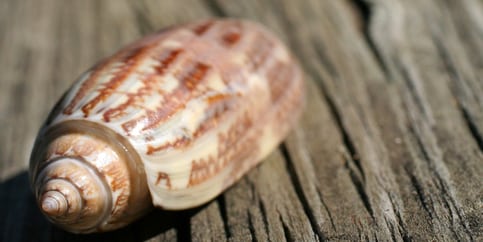
Lettered Olive
Named the South Carolina state shell in 1984, the lettered olive is smooth and shiny with a cylindrical shape and brown markings. These shells can be up to three inches long, and they’re found all along the South Carolina coast and as far away as Brazil.
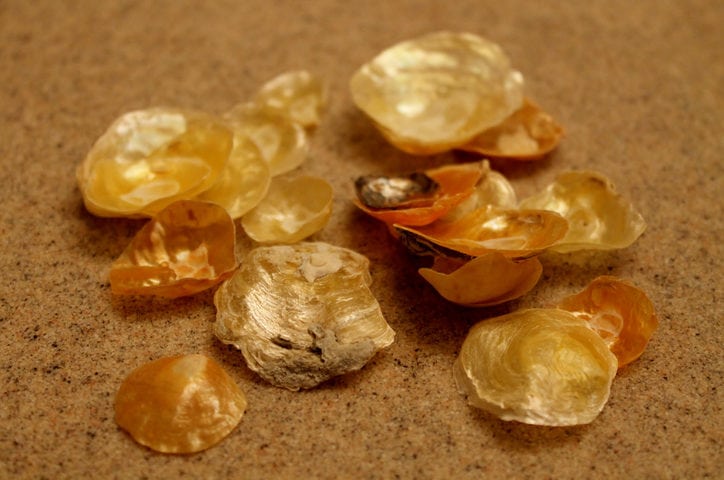
Jingle Shells
Jingle shells (aka witch’s toenail) are a favorite among beachgoers because of their shiny and colorful exteriors. They are often yellow, golden, brown, or silver. When strung as decoration, the shells make a jingling sound in the breeze.
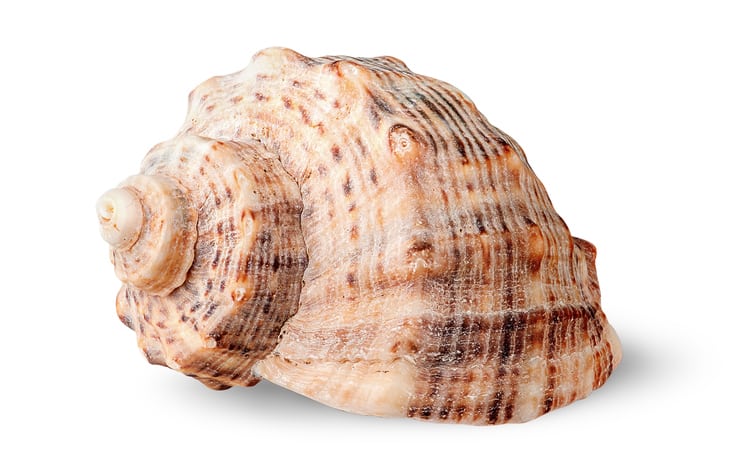
Whelk Shells
Sometimes confused for conch shells, whelks feature a similar shape and spiraled internal structure. Whelks are carnivorous predatory snails, and many varieties live along the S.C. coast. If you find one with a snail still inside, return it to the ocean as it is likely still alive!
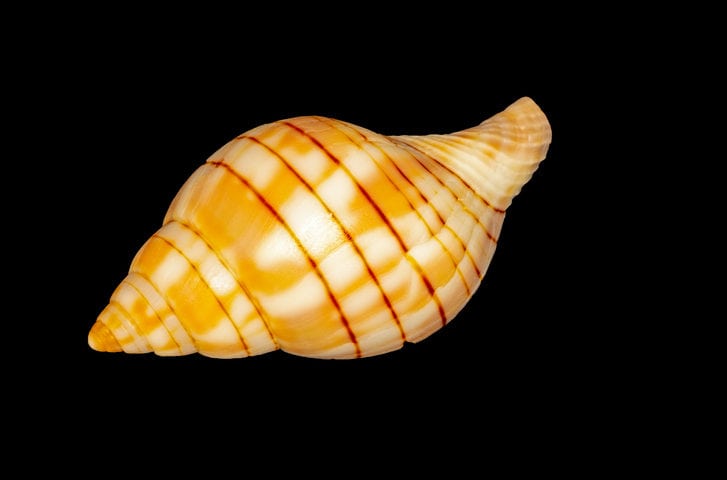
Banded Tulip
Spindle-shaped and cream-colored with streaks of of pink, the banded tulip shell features stripes around its body. The smooth and dainty shell packs a pretty ruthless snail inside. The carnivorous black snail uses its tongue to bore a hole through a victim’s shell and chow down on its prey.
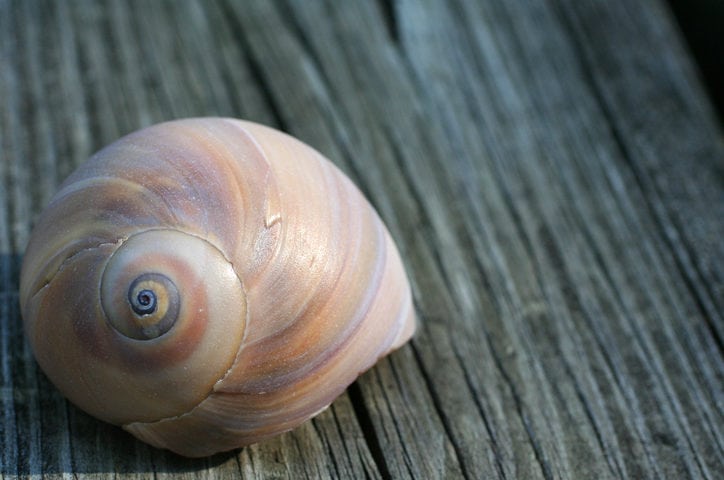
Atlantic Moon Snail Shell
The Atlantic moon snail shell is spherical and close to what you’d picture if you were thinking about a land snail. Like many of the other critters on this list, the Atlantic moon snail is a vicious predator. It bores a hole in the shell of its prey and sucks the creature out.
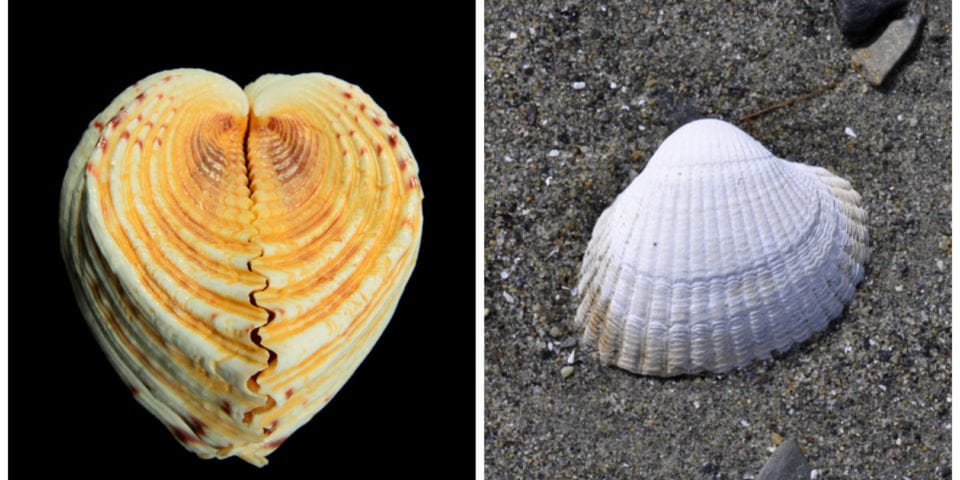
Heart Cockles
Commonly found along the shore of the Myrtle Beach area, heart cockles are clam shells—usually found separated—that resemble a heart when they are still joined. The shells can be three to five inches wide and feature a white or yellowish exterior and a pink, rosy interior.
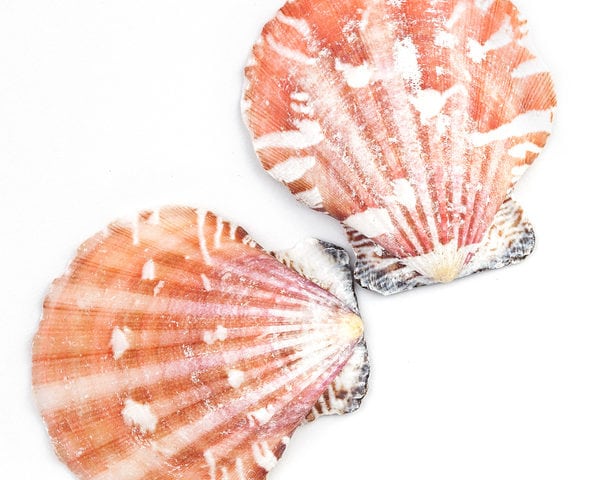
Calico scallop
Another common Myrtle Beach seashell is the calico scallop. This shell can be around three inches wide and features splotchy brown/red/maroon markings against a cream-colored background. These mollusks are distinct for their ability to actively swim, propelling themselves as fast as nine body lengths per second.
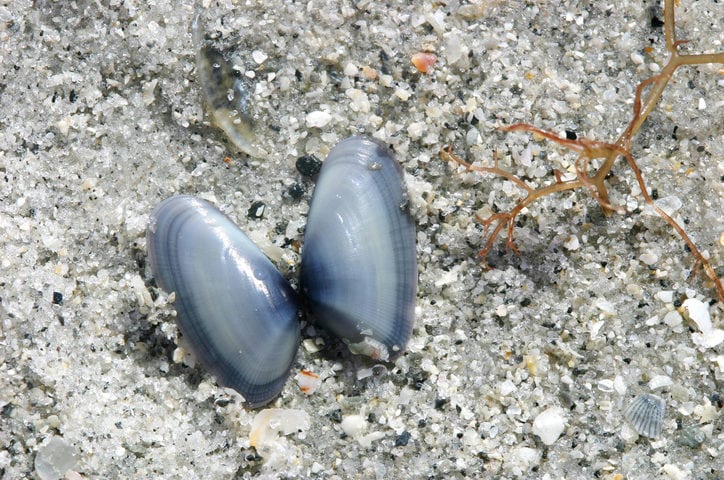
Coquina Clams
Often found alive and burrowing into the sand near the water’s edge, the coquina clam is a favorite find for beachgoing children. The small, smooth clamshells are less than an inch long and come in a variety of colors, including yellows, blues, pinks, and purples. The clams use short siphons to feed on plant material in the water.
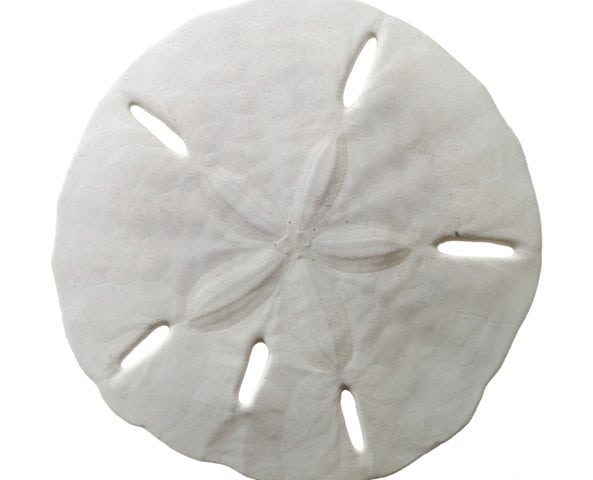
Sand Dollars
Sand dollars are burrowing sea urchins that live close to the shore just beneath the sand. They are known for the five markings on their skeleton. Live sand dollars are covered in small spines with tiny hairs sticking out; those spines allow the sand dollar to move around across the ocean floor. When alive, they have a reddish-brown appearance, but they turn to a whitish gray when dead.
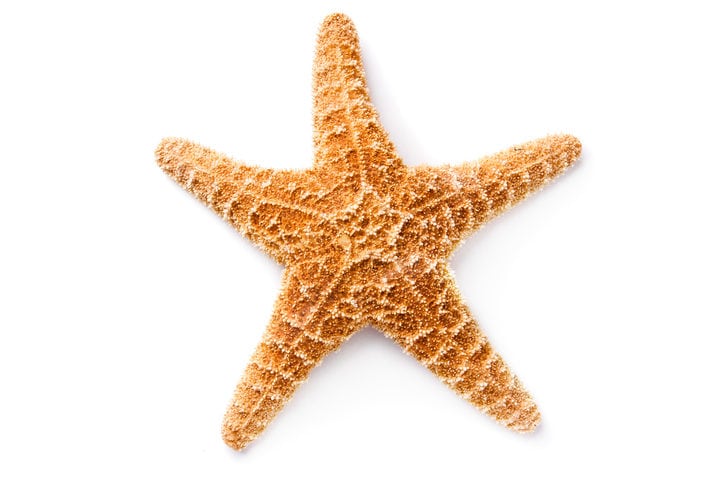
Starfish
Starfish is a misnomer for this creature, which many scientists would prefer to call the sea star, as this invertebrate is not actually a fish. Closely related to sand dollars and other sea urchins, starfish … er, sea stars … typically have five arms and bony skin to protect themselves from predators. They can regenerate limbs if necessary, and some species can actually regenerate a whole sea star from a single limb. Another cool fact: They consume food outside of their bodies by essentially spitting their stomachs into clam shells and devouring the contents before sucking their bellies back in.
You’re ready to start exploring to find the many shells of Myrtle Beach! Whether you’re meandering on the shore or taking a kayak tour, you’re sure to discover these natural souvenirs during your vacation. Just remember always to check the seashells you pick up and make sure they’re empty, and to leave live starfish and sand dollars where you find them.

